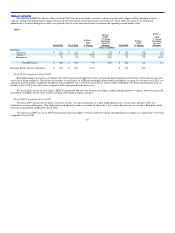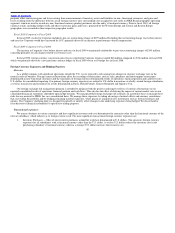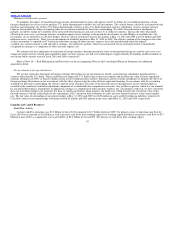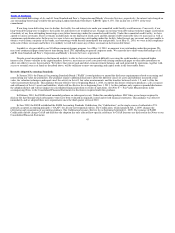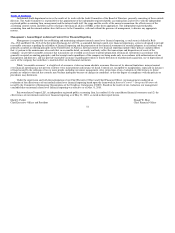Nike 2010 Annual Report Download - page 48
Download and view the complete annual report
Please find page 48 of the 2010 Nike annual report below. You can navigate through the pages in the report by either clicking on the pages listed below, or by using the keyword search tool below to find specific information within the annual report.
Table of Contents
senior unsecured debt ratings of A+ and A1 from Standard and Poor’s Corporation and Moody’s Investor Services, respectively, the interest rate charged on
any outstanding borrowings would be the prevailing London Interbank Offer Rate (“LIBOR”) plus 0.15%. The facility fee is 0.05% of the total
commitment.
If our long−term debt rating were to decline, the facility fee and interest rate under our committed credit facility would increase. Conversely, if our
long−term debt rating were to improve, the facility fee and interest rate would decrease. Changes in our long−term debt rating would not trigger acceleration
of maturity of any then outstanding borrowings or any future borrowings under the committed credit facility. Under this committed credit facility, we have
agreed to various covenants. These covenants include limits on our disposal of fixed assets and the amount of debt secured by liens we may incur as well as
a minimum capitalization ratio. In the event we were to have any borrowings outstanding under this facility, failed to meet any covenant, and were unable to
obtain a waiver from a majority of the banks, any borrowings would become immediately due and payable. As of May 31, 2010, we were in full compliance
with each of these covenants and believe it is unlikely we will fail to meet any of these covenants in the foreseeable future.
Liquidity is also provided by our $1 billion commercial paper program. As of May 31, 2010, no amounts were outstanding under this program. We
may issue commercial paper from time to time during fiscal 2011 depending on general corporate needs. We currently have short−term debt ratings of A1
and P1 from Standard and Poor’s Corporation and Moody’s Investor Services, respectively.
Despite recent uncertainties in the financial markets, to date we have not experienced difficulty accessing the credit markets or incurred higher
interest costs. Future volatility in the capital markets, however, may increase costs associated with issuing commercial paper or other debt instruments or
affect our ability to access those markets. We believe that current cash and short−term investment balances and cash generated by operations, together with
access to external sources of funds as described above, will be sufficient to meet our operating and capital needs in the foreseeable future.
Recently Adopted Accounting Standards
In January 2010, the Financial Accounting Standards Board (“FASB”) issued guidance to amend the disclosure requirements related to recurring and
nonrecurring fair value measurements. The guidance requires additional disclosures about the different classes of assets and liabilities measured at fair
value, the valuation techniques and inputs used, the activity in Level 3 fair value measurements, and the transfers between Levels 1, 2, and 3 of the fair
value measurement hierarchy. This guidance became effective for us beginning March 1, 2010, except for disclosures relating to purchases, sales, issuances
and settlements of Level 3 assets and liabilities, which will be effective for us beginning June 1, 2011. As this guidance only requires expanded disclosures,
the adoption did not and will not impact our consolidated financial position or results of operations. See Note 6 — Fair Value Measurements in the
accompanying Notes to the Consolidated Financial Statements for disclosures required under this guidance.
In February 2010, the FASB issued amended guidance on subsequent events. Under this amended guidance, SEC filers are no longer required to
disclose the date through which subsequent events have been evaluated in originally issued and revised financial statements. This guidance was effective
immediately and we adopted these new requirements since the third quarter of fiscal 2010.
In June 2009, the FASB established the FASB Accounting Standards Codification (the “Codification”) as the single source of authoritative U.S.
generally accepted accounting principles (“GAAP”) for all non−governmental entities. The Codification, which launched July 1, 2009, changes the
referencing and organization of accounting guidance. The Codification became effective for us beginning September 1, 2009. The issuance of FASB
Codification did not change GAAP and therefore the adoption has only affected how specific references to GAAP literature are disclosed in the Notes to our
Consolidated Financial Statements.
45



